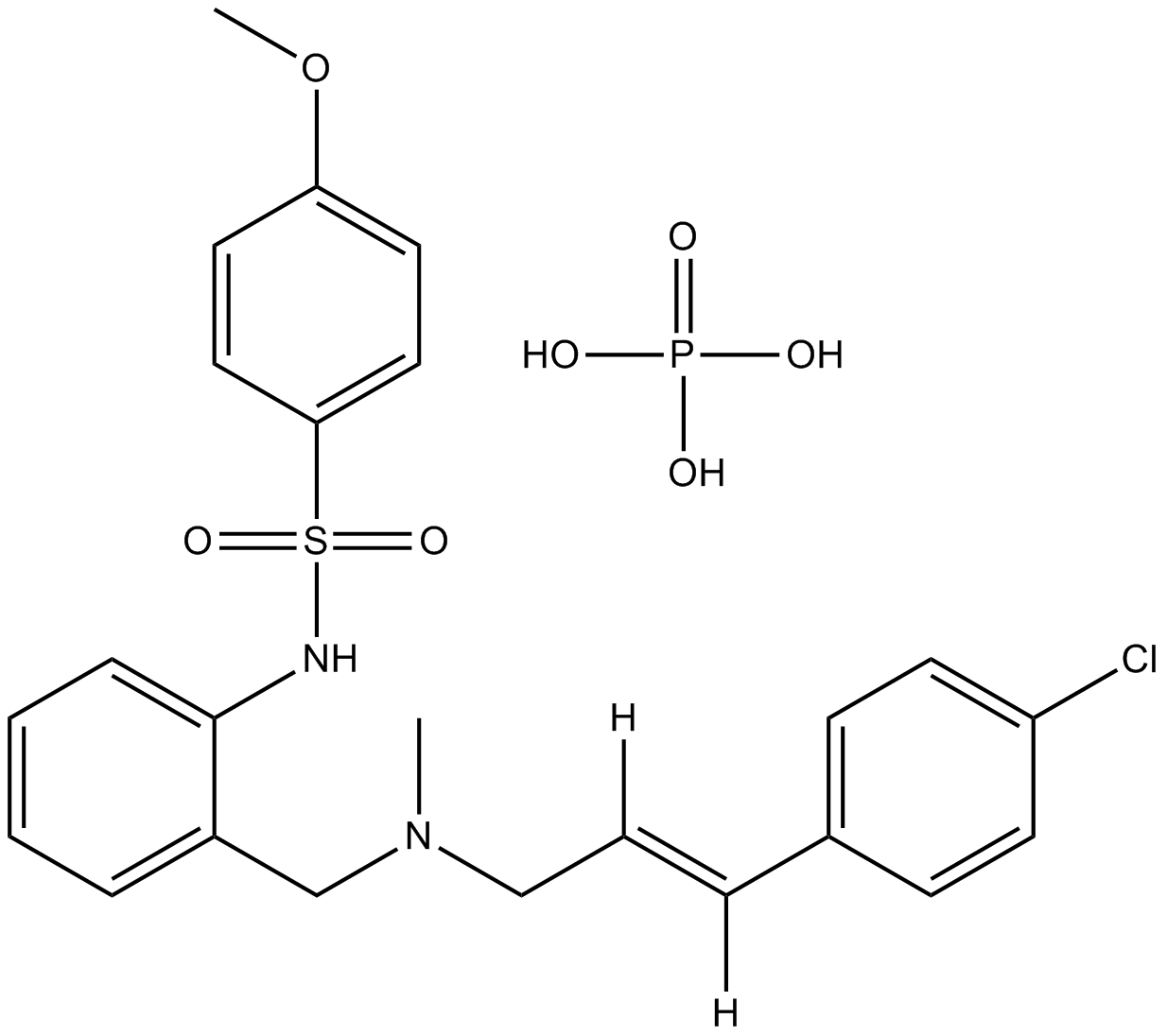
| 规格 | 价格 | 库存 | 数量 |
|---|---|---|---|
| 5mg |
|
||
| 10mg |
|
||
| 25mg |
|
||
| 50mg |
|
||
| 100mg |
|
||
| 250mg |
|
||
| 500mg | |||
| Other Sizes |
| 靶点 |
Inactive analog of KN-93; negative control
|
||
|---|---|---|---|
| 体外研究 (In Vitro) |
KN-93(5-50 μM;24 小时)可抑制 LX-2 细胞生长,但 KN-92(5-50 μM;24 小时)无法有效阻止细胞生长[2]。根据细胞周期调节因子表达的分析,发现 KN-93(而非 KN-92)会降低 p53 和 p21 的表达 [2]。
|
||
| 细胞实验 |
细胞活力测定[2]
细胞类型: 人肝星状细胞 (LX-2) 测试浓度: 5-50 μM 孵育持续时间:24 小时 实验结果:无法有效阻止细胞生长。 |
||
| 动物实验 |
|
||
| 参考文献 |
|
||
| 其他信息 |
KN-93, a Ca(2+)/calmodulin-dependent protein kinase II (CaMKII) inhibitor, concentration-dependently and reversibly inhibited inositol 1,4,5-trisphosphate receptor (IP(3)R)-mediated [Ca(2+)](i) signaling in mouse eggs and permeabilized A7r5 smooth muscle cells, two cell types predominantly expressing type-1 IP(3)R (IP(3)R-1). KN-92, an inactive analog, was ineffective. The inhibitory action of KN-93 on Ca(2+) signaling depended neither on effects on IP(3) metabolism nor on the filling grade of Ca(2+) stores, suggesting a direct action on the IP(3)R. Inhibition was independent of CaMKII, since in identical conditions other CaMKII inhibitors (KN-62, peptide 281-309, and autocamtide-related inhibitory peptide) were ineffective and since CaMKII activation was precluded in permeabilized cells. Moreover, KN-93 was most effective in the absence of Ca(2+). Analysis of Ca(2+) release in A7r5 cells at varying [IP(3)], of IP(3)R-1 degradation in eggs, and of [(3)H]IP(3) binding in Sf9 microsomes all indicated that KN-93 did not affect IP(3) binding. Comparison of the inhibition of Ca(2+) release and of [(3)H]IP(3) binding by KN-93 and calmodulin (CaM), either separately or combined, was compatible with a specific interaction of KN-93 with a CaM-binding site on IP(3)R-1. This was also consistent with the much smaller effect of KN-93 in permeabilized 16HBE14o(-) cells that predominantly express type 3 IP(3)R, which lacks the high affinity CaM-binding site. These findings indicate that KN-93 inhibits IP(3)R-1 directly and may therefore be a useful tool in the study of IP(3)R functional regulation. [1]
Aim: To investigate the effects of KN-93, a CaMKII selective inhibitor on cell proliferation and the expression of p53 or p21 protein in human hepatic stellate cells. Methods: Human hepatic stellate cells (LX-2) were incubated with various concentrations (0-50 micromol/L) of KN-93 or its inactive derivative, KN-92. Cell proliferation was measured by CCK-8 assay, and the expression of two cell cycle regulators, p53 and p21, was determined by SDS-PAGE and Western blotting. Results: KN-93 (5-50 micromol/L) decreased the proliferation of human hepatic stellate cells in a dose-dependent manner from 81.76% (81.76% +/- 2.58% vs 96.63% +/- 2.69%, P < 0.05) to 27.15% (27.15% +/- 2.86% vs 96.59% +/- 2.44%, P < 0.01) after 24 h treatment. Incubation of 10 micromol/L KN-93 induced the cell growth reduction in a time-dependent manner from 78.27% at 8 h to 11.48% at 48 h. However, KN-92, an inactive derivative of KN-93, did not inhibit cell proliferation effectively. Moreover, analysis of cell cycle regulator expression revealed that KN-93 rather than KN-92 reduced the expression of p53 and p21. Conclusion: KN-93 has potent inhibitory effect on proliferation of LX-2 cells by modulating the expression of two special cell cycle regulators, p53 and p21. [2] |
| 分子式 |
C24H28CLN2O7PS
|
|
|---|---|---|
| 分子量 |
554.98
|
|
| 精确质量 |
554.104
|
|
| 元素分析 |
C, 51.94; H, 5.09; Cl, 6.39; N, 5.05; O, 20.18; P, 5.58; S, 5.78
|
|
| CAS号 |
1135280-28-2
|
|
| 相关CAS号 |
KN-92 hydrochloride;1431698-47-3;KN-92;176708-42-2
|
|
| PubChem CID |
16219540
|
|
| 外观&性状 |
White to off-white solid powder
|
|
| LogP |
5.519
|
|
| tPSA |
154.59
|
|
| 氢键供体(HBD)数目 |
4
|
|
| 氢键受体(HBA)数目 |
9
|
|
| 可旋转键数目(RBC) |
9
|
|
| 重原子数目 |
36
|
|
| 分子复杂度/Complexity |
700
|
|
| 定义原子立体中心数目 |
0
|
|
| SMILES |
CN(C/C=C/C1=CC=C(C=C1)Cl)CC2=CC=CC=C2NS(=O)(=O)C3=CC=C(C=C3)OC.OP(=O)(O)O
|
|
| InChi Key |
XRQHWVVDNMJDEQ-IPZCTEOASA-N
|
|
| InChi Code |
InChI=1S/C24H25ClN2O3S.H3O4P/c1-27(17-5-6-19-9-11-21(25)12-10-19)18-20-7-3-4-8-24(20)26-31(28,29)23-15-13-22(30-2)14-16-23;1-5(2,3)4/h3-16,26H,17-18H2,1-2H3;(H3,1,2,3,4)/b6-5+;
|
|
| 化学名 |
(E)-N-(2-(((3-(4-chlorophenyl)allyl)(methyl)amino)methyl)phenyl)-4-methoxybenzenesulfonamide phosphate
|
|
| 别名 |
|
|
| HS Tariff Code |
2934.99.9001
|
|
| 存储方式 |
Powder -20°C 3 years 4°C 2 years In solvent -80°C 6 months -20°C 1 month 注意: 请将本产品存放在密封且受保护的环境中,避免吸湿/受潮。 |
|
| 运输条件 |
Room temperature (This product is stable at ambient temperature for a few days during ordinary shipping and time spent in Customs)
|
| 溶解度 (体外实验) |
|
|||
|---|---|---|---|---|
| 溶解度 (体内实验) |
配方 1 中的溶解度: ≥ 2.5 mg/mL (4.50 mM) (饱和度未知) in 10% DMSO + 90% (20% SBE-β-CD in Saline) (这些助溶剂从左到右依次添加,逐一添加), 澄清溶液。
例如,若需制备1 mL的工作液,可将100 μL 25.0 mg/mL澄清DMSO储备液加入900 μL 20% SBE-β-CD生理盐水溶液中,混匀。 *20% SBE-β-CD 生理盐水溶液的制备(4°C,1 周):将 2 g SBE-β-CD 溶解于 10 mL 生理盐水中,得到澄清溶液。 配方 2 中的溶解度: 2.5 mg/mL (4.50 mM) in 10% DMSO + 90% Corn Oil (这些助溶剂从左到右依次添加,逐一添加), 澄清溶液; 超声助溶. 例如,若需制备1 mL的工作液,可将 100 μL 25.0 mg/mL 澄清 DMSO 储备液添加到 900 μL 玉米油中并混合均匀。 请根据您的实验动物和给药方式选择适当的溶解配方/方案: 1、请先配制澄清的储备液(如:用DMSO配置50 或 100 mg/mL母液(储备液)); 2、取适量母液,按从左到右的顺序依次添加助溶剂,澄清后再加入下一助溶剂。以 下列配方为例说明 (注意此配方只用于说明,并不一定代表此产品 的实际溶解配方): 10% DMSO → 40% PEG300 → 5% Tween-80 → 45% ddH2O (或 saline); 假设最终工作液的体积为 1 mL, 浓度为5 mg/mL: 取 100 μL 50 mg/mL 的澄清 DMSO 储备液加到 400 μL PEG300 中,混合均匀/澄清;向上述体系中加入50 μL Tween-80,混合均匀/澄清;然后继续加入450 μL ddH2O (或 saline)定容至 1 mL; 3、溶剂前显示的百分比是指该溶剂在最终溶液/工作液中的体积所占比例; 4、 如产品在配制过程中出现沉淀/析出,可通过加热(≤50℃)或超声的方式助溶; 5、为保证最佳实验结果,工作液请现配现用! 6、如不确定怎么将母液配置成体内动物实验的工作液,请查看说明书或联系我们; 7、 以上所有助溶剂都可在 Invivochem.cn网站购买。 |
| 制备储备液 | 1 mg | 5 mg | 10 mg | |
| 1 mM | 1.8019 mL | 9.0093 mL | 18.0187 mL | |
| 5 mM | 0.3604 mL | 1.8019 mL | 3.6037 mL | |
| 10 mM | 0.1802 mL | 0.9009 mL | 1.8019 mL |
1、根据实验需要选择合适的溶剂配制储备液 (母液):对于大多数产品,InvivoChem推荐用DMSO配置母液 (比如:5、10、20mM或者10、20、50 mg/mL浓度),个别水溶性高的产品可直接溶于水。产品在DMSO 、水或其他溶剂中的具体溶解度详见上”溶解度 (体外)”部分;
2、如果您找不到您想要的溶解度信息,或者很难将产品溶解在溶液中,请联系我们;
3、建议使用下列计算器进行相关计算(摩尔浓度计算器、稀释计算器、分子量计算器、重组计算器等);
4、母液配好之后,将其分装到常规用量,并储存在-20°C或-80°C,尽量减少反复冻融循环。
计算结果:
工作液浓度: mg/mL;
DMSO母液配制方法: mg 药物溶于 μL DMSO溶液(母液浓度 mg/mL)。如该浓度超过该批次药物DMSO溶解度,请首先与我们联系。
体内配方配制方法:取 μL DMSO母液,加入 μL PEG300,混匀澄清后加入μL Tween 80,混匀澄清后加入 μL ddH2O,混匀澄清。
(1) 请确保溶液澄清之后,再加入下一种溶剂 (助溶剂) 。可利用涡旋、超声或水浴加热等方法助溶;
(2) 一定要按顺序加入溶剂 (助溶剂) 。